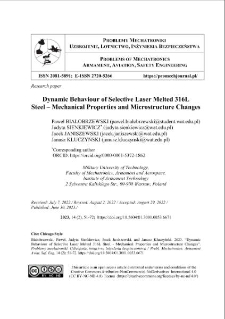Nasza Biblioteka Cyfrowa udostępnia 1 868 obiektów cyfrowych
Obiekt
Tytuł: Dynamic Behaviour of Selective Laser Melted 316L Steel – Mechanical Properties and Microstructure Changes ; Dynamic Behaviour of Selective Laser Melted 316L Steel – Mechanical Properties and Microstructure Changes
Tytuł odmienny:
Dynamiczne zachowanie próbek ze stali 316L wytworzonych za pomocą metody SLM – właściwości mechaniczne i zmiany mikrostruktury ; Dynamiczne zachowanie próbek ze stali 316L wytworzonych za pomocą metody SLM – właściwości mechaniczne i zmiany mikrostruktury
Współtwórca:
Judyta SIENKIEWICZ, Jacek JANISZEWSKI, Janusz KLUCZYŃSKI ; Judyta SIENKIEWICZ, Jacek JANISZEWSKI, Janusz KLUCZYŃSKI
Abstrakt:
316L steel specimens with three different shear zones made by SLM (Selective Laser Melting) were subjected to dynamic tests using the Split Hopkinson Pressure Bar method. The effect of high-speed deformation on changes in microstructure was analyzed. In addition, the stress-strain relationship was determined from the SHPB results. To visualize the deformation process of the specimens during the tests, a camera with a high frame rate was used. It was shown that as the plastic deformation increases, the hardness of the material increases. Microstructural analysis of dynamically loaded areas revealed numerous defects. Twinning was found to be the main deformation mechanism. Large plastic deformation and many other microstructural changes such as shear bands, cracks and martensite nucleation were also observed.
;
316L steel specimens with three different shear zones made by SLM (Selective Laser Melting) were subjected to dynamic tests using the Split Hopkinson Pressure Bar method. The effect of high-speed deformation on changes in microstructure was analyzed. In addition, the stress-strain relationship was determined from the SHPB results. To visualize the deformation process of the specimens during the tests, a camera with a high frame rate was used. It was shown that as the plastic deformation increases, the hardness of the material increases. Microstructural analysis of dynamically loaded areas revealed numerous defects. Twinning was found to be the main deformation mechanism. Large plastic deformation and many other microstructural changes such as shear bands, cracks and martensite nucleation were also observed.
Miejsce wydania:
Warszawa
;
Warszawa
Wydawca:
Wojskowa Akademia Techniczna ; Wojskowa Akademia Techniczna
Data utworzenia:
Data złożenia:
Data akceptacji:
Data wydania:
Rozmiar:
Identyfikator:
oai:ribes-88.man.poznan.pl:2673
Sygnatura:
doi:10.5604/01.3001.0053.6671 ; doi:10.5604/01.3001.0053.6671
ISSN elektroniczny:
ISSN drukowany:
Język:
Licencja:
kliknij tutaj, żeby przejść ; kliknij tutaj, żeby przejść
Właściciel praw:
Wojskowa Akademia Techniczna ; Wojskowa Akademia Techniczna
Strona początkowa:
Strona końcowa:
Tom:
Czasopismo:
Słowa kluczowe:
microstructure, stainless steel, selective laser melting, additive manufacturing, split Hopkinson pressure bar ; microstructure, stainless steel, selective laser melting, additive manufacturing, split Hopkinson pressure bar
Kolekcje, do których przypisany jest obiekt:
Data ostatniej modyfikacji:
15 paź 2025
Data dodania obiektu:
15 paź 2025
Liczba wyświetleń treści obiektu:
0
Wszystkie dostępne wersje tego obiektu:
https://ribes-88.man.poznan.pl/publication/3006
Wyświetl opis w formacie RDF:
Wyświetl opis w formacie OAI-PMH:
| Nazwa wydania | Data |
|---|---|
| Dynamic Behaviour of Selective Laser Melted 316L Steel – Mechanical Properties and Microstructure Changes | 15 paź 2025 |

